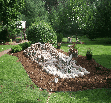The right tool can help make any job easier and the garden is no exception. More than 91 million households gardened in 2005, the most ever, according to the National Gardening Association. Gardening is an incredibly enjoyable activity, but if you don’t want to end up sore, blistered or itching, it’s important to be properly prepared before you begin.
Here are some essential items that I keep in my garden shed:
• Gardener’s First-Aid Kit-The most important thing in my shed is my first-aid kit for common garden emergencies including sunburn, bug bites, cuts, and poison ivy, oak or sumac. Every gardener I know dreads poison ivy because the itch can last for weeks. A tiny brush against one of these plants can cause a whole lot of itch, but it doesn’t have to with the help of one of my favorite products, Cortaid® Poison Ivy Care Treatment Kit. It can be used to defend against an outbreak, help to prevent spreading and treat an itchy reaction.
• Gardening Gloves-While I believe in getting my hands dirty, nothing beats a great pair of high-quality leather gardening gloves. The right gloves can protect hands from thorns, an unexpected bee or spider, sharp twigs or sticks and blistering.
• Shovels/Spade & Trowel-A good shovel is the difference between making your garden work easier and giving you a backache. Look for one with a long handle (to take pressure off of your back) and flat ledge, which creates a surface for your foot. A trowel is a must. Find one with a wide, curved blade that fits comfortably in your hand.
• Pruners-Pruning, deadheading (picking the dead flowers off of plants) and trimming plants goes on all year long. Look for “bypass” pruners that make a clean cut on the plant without crushing or tearing it.
• Wheelbarrows and Carts-Toting things around the garden can become a chore. Save yourself a backache and find a lightweight yet sturdy and steady cart to help with heavy work.
• Watering Essentials-A good hose has a 5/8-inch opening, is reinforced with a mesh layer and is kink resistant. It should handle 50 pounds per square inch of water pressure. Cost usually reflects quality, so spend the extra. For areas your hose can’t reach, invest in a sturdy watering can.
With tools like these, gardening will truly be a pleasure, so get out there and “Get Your Hands Dirty.”
Rebecca Kolls, a master gardener, is host of HGTV’s nationally syndicated gardening series “Rebecca’s Garden.”
Before digging in the garden, be sure you have the right tools.







